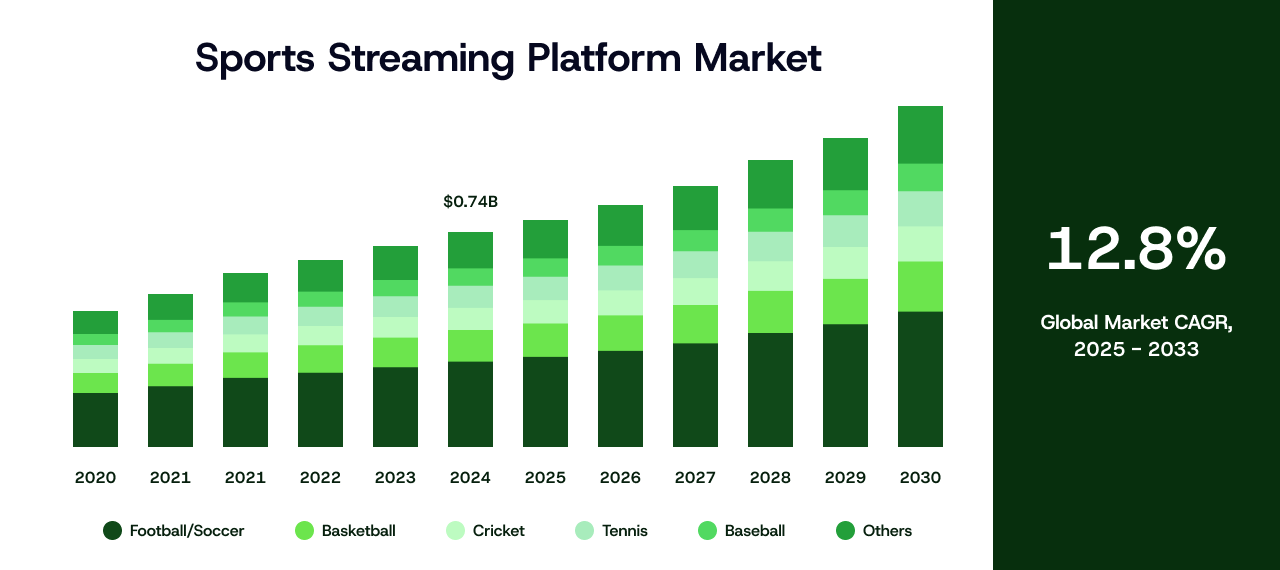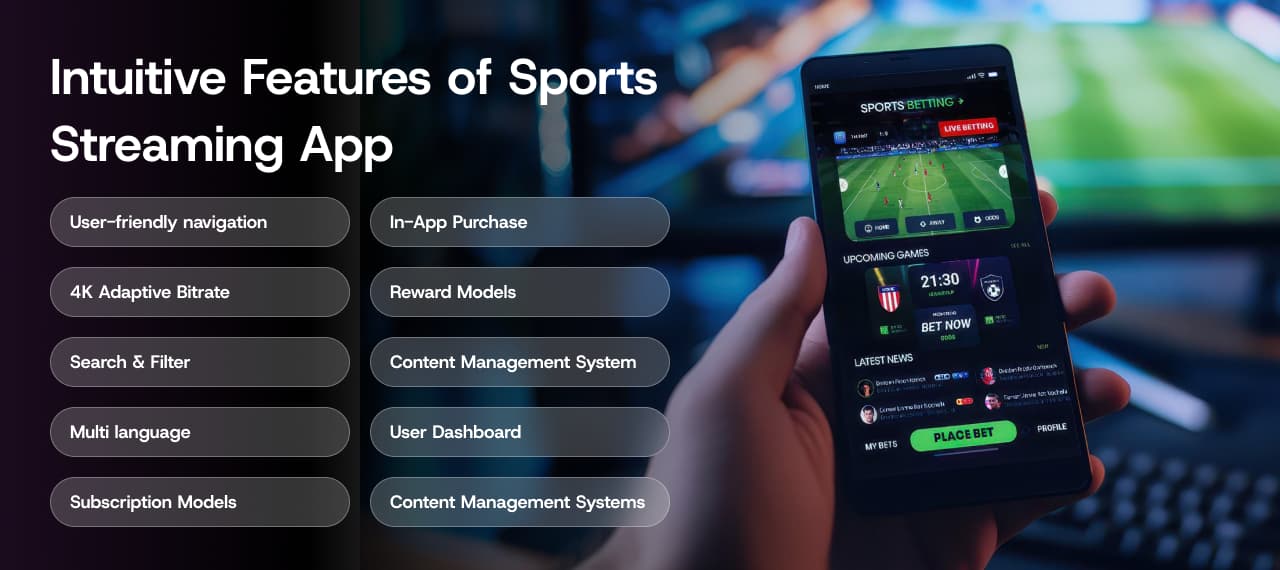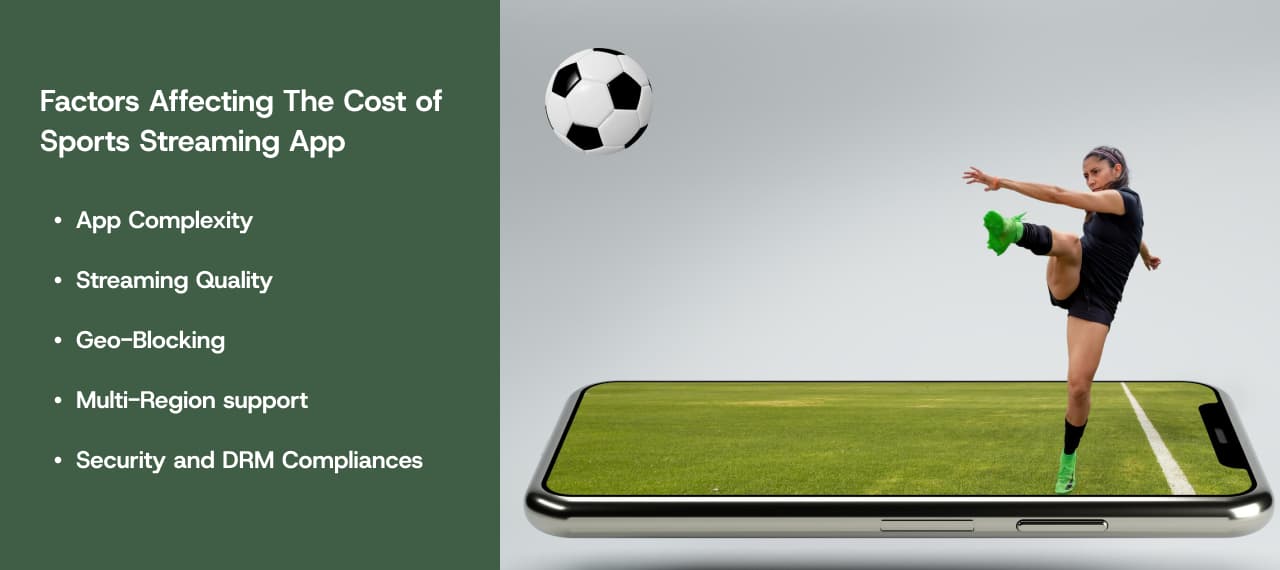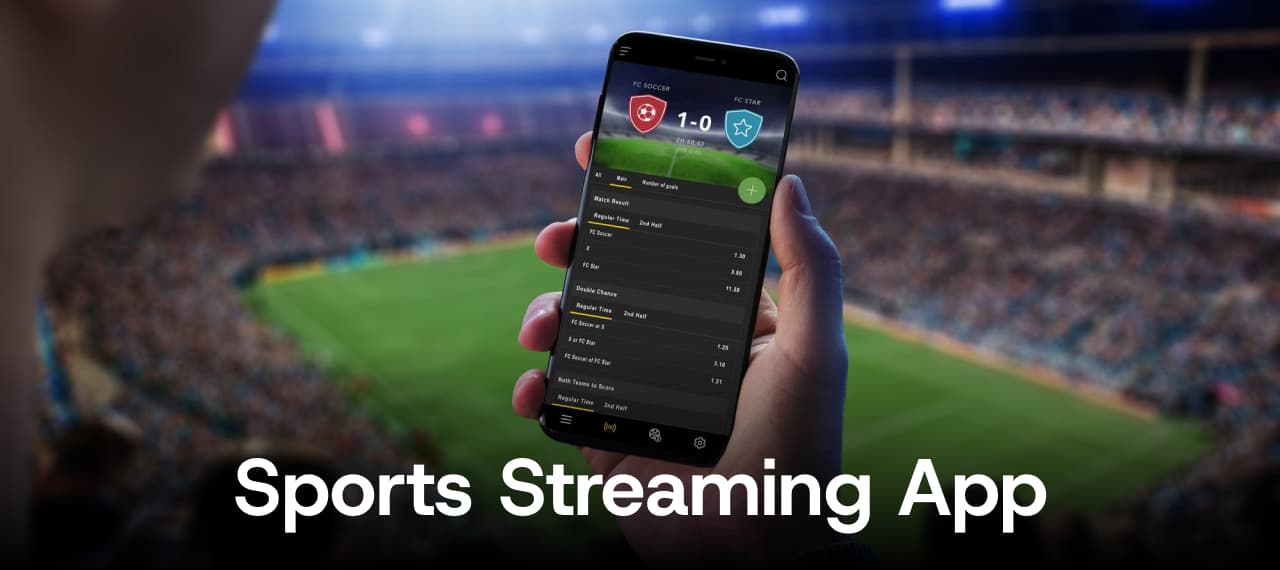Table of Contents
- Market Overview
- Why in a Sports Streaming App
- Key App Features
- Recommended Tech Stack
- Development Cost Breakdown
- Legal & Licensing
- Monetization Strategies
- Maintenance & Scaling Tips
- Stand Out Tips
- Top App Case Studies
- Final Thoughts
The way fans consume sports content has changed dramatically in recent years. With the decline of traditional cable TV and the rapid adoption of smartphones and high-speed internet, live sports streaming has surged to the forefront of digital entertainment.
It is also what has enabled viewers to come to demand live matches, highlights and commentary, no matter what the device, anytime, anywhere. Not only has this change disrupted fan experiences as originally constructed, but it’s also created opportunities for content creators, media companies and tech innovators.
Five years into the future, in 2025, and sports streaming apps are still the dominators in the online world, powered by rising mobile penetration, rollout of 5G, and growing demand for on- demand, interactive content.
The global sports streaming market is expected to reach more than $8 billion by 2030, as industry estimates indicate the share of sports content will be the most lucrative, with the surge in OTT platforms and niche sports coverage at the center of it. Be it cricket in India, football in Europe or UFC in the US, fans are gravitating towards platforms that are convenient, personalised and engaging.
This complete guide is for entrepreneurs, broadcasters start up sports companies, and agencies wanting to get in on this rapidly moving sector. From the key features that should form the core of your app and your tech stack, to the ways you can make money off your app and even your development costs, we’ll list everything you need to build a winning sports streaming app.
So, let’s jump right in to the game-changing opportunity of digital sports broadcasting.
1. Sports Streaming Market Overview

The market for the sports streaming service worldwide is growing significantly. It is estimated to grow from USD 0.74 billion in 2024 to reach USD 2.22 billion by 2033, at a CAGR of 12.8% from 2025 to 2033. The total overall market of sports broadcasting technology, comprising streaming, infrastructure, analytics, was worth $84.8 billion in 2025 and is forecast to be worth $146 billion by 2034, year-on-year growth of 6–7%.
This expansion is being fed by three powerful forces:
- Cord-cutting: We’re seeing a decline in traditional TV viewership and this means leagues including MLB are rejecting longstanding network deals (like ESPN which goes through 2025) in favour of putting streaming first.
- Niche leagues and content: The rise of niche leagues has led fans to expect coverage of niche sports, e-sports, local leagues, women’s sports, and more targeted platforms.
- Mobile-first consumption: The widespread use of smartphones and faster internet (including 5G) makes live, high-quality streaming on the go more achievable than ever.
Some of the major platforms spearheading the move are ESPN+, DAZN, Hulu + Live TV, and even unauthorized ones like StreamEast, indicating a willingness to watch for free, even if it means breaking the law.
The legal terrain is, however, complex. Where these rights are for live sport then they tend to be strictly controlled, unauthorised broadcast of the rights can result in fines or even criminal sanctions. Rights holders and platforms frequently agree to exclusive, high-paying deals e.g., the NBA’s recent contracts with Amazon, Disney, and NBC from 2025.
2. Why to Invest in a Sports Streaming App?
There are many reasons why you should invest in a sports streaming app. Here we have listed some of the key reasons to invest in a sports streaming app.
Mobile-First Viewing Is Here to Stay
Gen Z and millennials are moving away from traditional TV in favour of mobile streaming, which offers convenience and interactivity. Perfect for their on-the-go, always-connected consciousness, an app isn’t just a good idea, it’s a must-have.
Diverse Monetisation Opportunities
There are multiple revenue streams with sports streaming apps, subscription based, ad-supported, pay-per-view events. This flexibility also means you can easily customize monetisation to your audience and type of content.
Increase Fan Engagements and Loyalty
Interactive elements like in-app chat, fantasy league integrations and personalised match alerts convert casual viewers into rabid fans. The result is greater watch times, deeper brand affinity and higher repeat engagement.
Gain a Competitive Advantage
A streaming app is also its own draw for broadcasters, leagues and media companies, which can cut out middlemen by controlling their own platform. It’s the only way to really control content delivery, understand your data and optimize your user experience, giving you a head start over every other sports property in the digital world.
3. Must-Have Features for a Sports Streaming App

Building a sports streaming app that works is about more than streaming games, it’s about delivering a frictionless and engaging experience both for your users and for sports broadcasters and content owners. From front-end features that lead to user retention to backend tools that enable scalability and analytics, the right feature set is key to success in what is a rapidly moving streaming landscape.
User Features
- User Registration & Profiles
An intuitive bootstrapping is necessary. Let users sign up or sign in with email, phone numbers, or third-party accounts such as Google, Apple ID, and Facebook. Profiles should have personalisation abilities like favourite teams, language preference and content preference.
- Life HD – 4k + Adaptive Bitrate)
Smooth, high-quality live video is the backbone of any sports streaming app. Your platform should be able to support HD and 4K streaming aided by adaptive bitrate technology so content is streamed smoothly, even in regions where internet connectivity is unstable.
- Video on Demand (VOD)
Fans don’t always watch live. By also providing match replays, highlights, interviews and archives, they can keep users on the platform well beyond the full-time whistle. VOD also improves watch time and retention.
- Search & Filters
Enable users to easily find content through interactive search and filters. Filter by sport, team, game, league, date, or popularity. Intuitive navigation is vital for a good user experience.
- Push Notifications
Real-time notifications are crucial for engagement. Inform users about the next scheduled game, live scores, leader changes or new content posts. Allow them to personalise what they are alerted about to prevent spam.
- Multi-language Support
Global fans of sports expect access in their native language. Add multilingual content, close caption, dub or voiceover to make it available and welcoming for all users.
Interactive Features
- In-app Chat or Live Commentary
Build community around every game for real-time chat or live commentary feeds. This creates fan inter activity, and also offers a “second screen” experience where fans can chat strategy, cheer on plays, or argue about referee calls.
- Polls, Reactions & Emojis
Supercharge the interactivity with live polls, emoji reactions and fan predictions. All of these characteristics make viewers feel like part of the action, transforming passive watching into the ability to actively participate.
- Fantasy Sports Integration
When you connect your app to fantasy leagues, it adds a gamified element to the experience. Enable users to draft players for points based on real-time performance raced against friends when watching games live.
Monetisation Features
- Subscription Models
Provide subscription model (month, annual, VIP) with different levels of access (free user, basic content, Premium, Vip user, special events). Include flexible payment choices and free trial periods to elevate conversion.
- In-app Purchases
Sell match passes, merchandise, poll tokens, or behind-the-scenes content. Engaged fanbases are particularly fertile for microtransactions as well, they add.
- Reward Systems
Design a points-based loyalty scheme and reward use cases, such as for watching games, inviting friends and using content. These rewards points can be converted to rewards, such as discounts or items.
- Ad Placements
Monetize free users with non-invasive ads. Include banners, mid-roll, pre-roll and ads – but not based on estimated time on site, they should be driven by a clever ad engine, to stay relevant and keep your audience.
Admin Features
- Content Management System (CMS)
Administrators should be able to upload, schedule and monitor content directly from a simple dashboard interface. CMS should facilitate the upload of in bulk, tagging and customisation by region.
- Analytics Dashboard
Monitor user behavior, retention, streaming quality ads revenue and content performance. “Data insights are integral to ensuring the experience is optimised and for making business decisions.”
- User Management Tools
Control user access, support, feedback and activity. Secure admin panel avoid its misuse and it will increase the trust.
- Monetisation Controls
Effortlessly control ad slots, pricing plans, payment gateways and promotions. Having that monetisation wouldn’t scale and you can’t experiment with your revenue model over time.
4. Recommended Tech Stack for Building Sports Streaming Apps

The best tech stack is the cornerstone of sports streaming app development. Heavy frontend, backend, streaming protocols, and API features work together to provide a seamless user experience, low-latency video delivery and a highly scalable infrastructure to handle peak traffic in live events.
Frontend Technologies
React Native / Flutter (Cross-Platform Development)
React Native and Flutter are two of the most popular cross-platform frameworks to build mobile apps with a single codebase. Facebook-backed React Native is based on JavaScript, and has a thriving ecosystem, while Google’s Flutter works on Dart and offers customisable UIs with native performance. Either way you get to market fast on Android and iOS with no duplication of development efforts.
Swift (iOS) and Kotlin (Android) with Native Apps
For more performance sensitive or feature rich apps, one may prefer native development. Swift is the language of choice for iOS apps, prized for its speed and safety; Kotlin is now the favoured language for Android, featuring modern syntax and strong Google support. Native apps perform best, especially with video streaming and real-time uses.
HTML5 Video Player (Web-Based)
An HTML5 player is needed to cater to web users. It works with adaptive streaming, can be used cross-browser, and is utilized on a variety mobile and desktop clients. The ability to integrate it with custom controls, captions and DRM is crucial for a full-featured web experience.
Backend Technologies
Node.js / Django / Laravel (for Application Logic & APIs)
Your backend manages user, streaming, payment, and data.
- Node. js is event driven and very scalable, ideal for realtime applications such as a chat client or live stats.
- Django itself is a high-level framework written in Python that is able to provide safety and speed, as well as a ready admin panel.
- Laravel definitely one of the best PHP framework for teams that come from a LAMP stack background.
Cloud deployment: Whether you prefer AWS or Google Cloud (GCP)
AWS and GCP are two of the leading hosting providers, they both offer auto-scaling servers, worldwide availability, and out-of-the-box services including storage (S3 or Cloud Storage), load balancing, and managed databases. Many use AWS for powerful video streaming capabilities, with GCP leaning on strong AI/ML integrations to support content recommendations.
CDNs: Cloudflare, Akamai, AWS CloudFront
Your videos load faster and play smoother when served from a Content Delivery Network (CDN) – even under high traffic!
- DDoS protection and global presense is why everyone is using Cloudflare.
- Akamai is preferred for massive enterprise video delivery.
- It’s well integrated with infrastructure that is hosted on AWS CloudFront.
Media Servers: Wowza, Red5 Pro, MUX
Media servers encode, transcode, and transmit live or recorded streams.
- Wowza offers an impressive variety of streaming protocols and sophisticated analytics.
- Red5 Pro is ideal for ultra-low latency streaming and works with WebRTC.
- MUX simplifies the video workflow with APIs to upload, playback, and real-time stats.
Databases: PostgreSQL or MongoDB
- Your Database for the user profiles, match schedules, metadata about content, chat messages, and so much more.
- If you have complex relational data and strong consistency, PostgreSQL is a better option.
- And MongoDB is really good in a dynamic kind of way, while being very fluid in building objects quickly.
Streaming Protocols
HLS (HTTP Live Streaming)
HLS is the dominant protocol, and was developed by Apple. It divides video into small chunks and supports adaptive bit rate streaming, which is essential for the mobile users with different network speed.
RTMP (Real-Time Messaging Protocol)
RTMP is still being used to ingest video because of its low latency and robustness. It’s mostly replaced, on the playback side, by HLS, but is still crucial when broadcasting from live sources like cameras.
WebRTC
WebRTC supports peer-to-peer video and audio communication in real time-great for interactive experiences such as in-app chat, live reactions and virtual watch parties.
APIs & Third-Party Tools
Authentication: Firebase Auth or Auth0
Login needs to be secure and feel painless. Firebase Auth has built-in support for email/password as well as social logins such as oauth2 with Google, Facebook, Twitter, and more, and even phone number based sign-ins! Auth0 is a much more feature-rich and flexible option.
Payments: Stripe, Razorpay, PayPal
Add secure payment gateways to cater for subscriptions, pay-per views or donations. Stripe gives you the ease of integration and adoption from amongst most developers and Razorpay (from India) is preferred for Indian markets. PayPal makes it easy to get started and to reach international markets.
Analytics: Mixpanel, Google Analytics
Track user engagement, retention and content performance. Mixpanel does event-based tracking and funnel analysis and Google Analytics is all about traffic sources, demographics and device usage.
Push Notifications: OneSignal, Firebase Cloud Messaging (FCM)
It provides real-time push notifications for match alerts, updates and to run engagement campaigns. But both do segmentation, A/B testing, and cross-platform work.
DRM: Google Widevine, Apple FairPlay
Implement DRM solutions to safeguard that content and meet broadcast rights. Widevine (Netflix) used by Chrome and Android, while FairPlay (Netflix, Hulu) used by iOS and Safari restrict screen recording, protecting content from theft and piracy.
5. How Much Does It Cost to Develop a Sports Streaming App

Creating a live streaming platform can be an affect-management investment, which consists of many elements, adding value to your final budget. Whether you are working on a simple MVP or a sophisticated platform including interactive and monetisation features, knowing the cost structure is simply the best way to plan wisely and steer clear from hidden costs.
Factors Affecting Cost
App Complexity & Features
The more modules your app has, such as live streaming, VOD, support for multiple languages, user profiles, chat, payment gateways, the greater the price of creation. It’s faster and cheaper to create basic apps with a few features than feature-packed and polished premium platforms.
Streaming Quality (HD vs 4K)
The need to distribute HD or 4K video content has a colossal impact on development and infrastructure costs.” High resolution requires more bandwidth, storage and server performance contributing in some/any cases to CDN and cloud hosting costs. The implementation of ABS would also complicate ease of playback across divergent devices and networks.
Geo-Blocking & Multi-Region Support
If your app needs to be available in different regions that may have different content rights, you’ll need to implement geo-blocking logic, dynamic content licensing rules, and perhaps even different UI layouts for different regions. These legal and technological requirements add development overhead and server setup.
Security & DRM Compliance
Yet securing the high-value sports content demands sophisticated security techniques, such as encryption, token-based access, secure streaming protocols, and Digital Rights Management (DRM) systems like Google Widevine and Apple FairPlay. These are must haves for any app delivering official or premium content, and come with additional licensing and integration costs.
Development Cost Breakdown
Here we provide a rough estimate of how much it CAN cost to develop an application like a live sports streaming app with a fair feature set:
| Task | Estimated Cost (USD) |
| UI/UX Design | $5,000 – $15,000 |
| Frontend Development | $10,000 – $30,000 |
| Backend Development | $15,000 – $40,000 |
| Video Streaming Setup | $5,000 – $20,000 |
| CDN & Hosting Configuration | $3,000 – $10,000 |
| QA & Testing | $3,000 – $7,000 |
| Post-Launch Maintenance | $1,000 – $5,000/month |
These are rough estimates that vary depending on the complexity, user base size, and experience of your development team or vendor. Well, anything where ads interstitials live pollings Fantasy sports AI based Recommendation etc, you may consider the cost to be or more than at the higher end or above this range.
Outsourcing vs In-House Development
In-House Development
Being able to hire your own in-house team ensures that you have a lot more control and offers quicker communication, as well as stronger product ownership. But it can also be more expensive, particularly in a country like the US or UK.
Hourly Rates:
- USA: $100–$150/hr
- UK: $80–$120/hr
- Europe: $60–$100/hr
Pros:
- Direct collaboration
- Aligned vision and goals
- Long-term scalability
Cons:
- Higher costs
- Slower hiring process
- Need for internal infrastructure
Outsourcing to Agencies or Freelancers
By outsourcing to trusted development firms or freelancers in India, Ukraine, or the Philippines for example, you can greatly minimize your initial investment, without sacrificing the quality of the product.
Hourly Rates:
- India: $20–$40/hr
- Eastern Europe: $30–$60/hr
- Southeast Asia: $15–$35/hr
Pros:
- Cost-effective
- Faster team assembly
- Access to specialised expertise
Cons:
- Time zone differences
- Communication barriers
- Requires strong project management
Developing a sports streaming app may cost you from $40,000 to $120,000 or more according to your requirements. With the right tech partner and a clear vision, you can create a scalable, compelling platform that offers strong ROI and places your brand at the heart of the digital sports revolution.
6. Legal Considerations & Licensing
To launch a sports streaming app, you need to understand the complicated legal landscape of digital content distribution. Not adhering to copyright laws, licensing agreements, and local legislation, can result in legal battles, platform bans, or extremely large fines, certainly in the world of sports latter, as content rights are heavily protected.
Streaming Rights & Copyright Laws
All live sports content is copyright protected and often owned by leagues, broadcasters or ruling bodies. To legally stream any event, you need to obtain distribution rights, whether through licensing deals or partnerships. These are frequently exclusive, time-limited and costly contracts. Without appropriate rights, your app may be the subject of takedown requests or litigation for copyright infringement.
Geo-Restriction & Compliance Per Region
Licensing is typically sold by country or region. What this means is that perhaps you will be able to watch a game in one country, and for some reason not in another. To comply with this, your service needs to enforce geographic blocking as a means to restrict content availability by user location. This will help to prevent an infringement on territorial rights and minimise any legal risks.
Data Privacy Regulations (GDPR, CCPA)
If your app processes any kind of user-specific information (e.g., for accounts, payments, analytics), you need for sure to stick to data protection laws as GDPR (EU) and CCPA (California). These rules include clear consent, encryption of data, and the option for users to control or erase their data.
DRM Technologies & User Safety
In order to protect against piracy and unauthorized content distribution, your OTT platform should support Digital Rights Management (DRM) technologies, like the Google Widevine and Apple FairPlay DRM solutions. Use these apps to secure your streams, protect your IP, and build trust with your audience by giving access to your users only!

7. How to Make Money From Your Sports Streaming App
The key to turning a high-engagement sports streaming app into a viable business is monetizing it properly. As the appetite for live and on-demand sports content continues to rise and they are more willing to pay for quality experiences – be it through subscriptions, advertising, or access to premium content. The ideal monetisation mix will vary based on your audience size, the region of the market you’re in, and the content rights.
Subscription-Based Model (SVOD)
The pervasive model, SVOD provides subscribers exclusive access to live matches, replays as well as premium features in return for a set monthly or annual cost. This model works well if you have licensed or original content that fans can’t get anywhere else. Tiered pricing (for example, basic, premium, family plans) allows you to segment user segments and unlock predictable revenue.
Ad-Supported Model (AVOD)
For services looking for broader distribution or targeting markets with low subscription adoption, AVOD provides free access with ads. This could be preroll before the game starts, midroll during commercial breaks or banner ads in the app. While used in tandem with programmatic ad platforms, AVOD can make a lot of money without directly charging users.
Freemium + PPV Model
This comes in the form of a hybrid model that makes some content available free of charge while putting premium events or special matches behind a paywall. PPV is perfect for one-off live contests such as finals, championship games, or unique international matches. It is particularly useful for niche leagues or international audiences.
Sponsorship & Partnerships
If you can do it in collaboration with a sports brand, league, or influencer, it lends you credibility and opens up new revenue sources. There are also opportunities for sponsorships to be woven into the app by way of branded content, in-banner placements or sponsored match segments, so it’s a win-win for both your band and your partners.
8. Maintenance, Scale & Performance Optimisation
Getting your sports broadcasting app out is only half the battle – keeping the app running smoothly and enhancing performance is essential to delivering a seamless and dependable user experience, even during heavy traffic events. Without a clear strategy, latency, buffering, or lag during a live game can make for a high lead time to user churn.
Content Delivery Network: A Content Delivery Network (CDN) such as Cloudflare, Akamai or AWS CloudFront will deliver your content from the edge server closest to the user, for faster load times and no buffering. This is particularly relevant when viewers from all over the world are watching at the same time.
Adaptive Bitrate Streaming: Adaptive Bitrate Streaming improves playback under varying network conditions. It dynamically optimizes the video quality according to the viewer’s internet connection speed, preventing any skip and buffering when catching up or streaming the videos.
Cloud Scaling: At some point your user base will expand, and you will need to scale across the cloud. Services such as AWS and Google Cloud have auto-scaling servers that allocate resources for you, especially during peak hours (e.g., large tournaments) so your app is responsive for millions of concurrent viewers.
Routine App Store Updates: Regular app store updates are necessary to introduce new features, make usability enhancements and stay compatible with device OS updates. Just as important are security patches and vulnerability fixes that help protect your app – and users – from threats, hacks, data breaches, and other vulnerabilities.
Regular performance audits, load testing, and feature updates based on user feedback are just a few of the techniques you’ll need to improve your app’s credibility and competitive position in the market long after the initial release date.
9. Tips To Differentiate In The Crowd Market
With myriad sports streaming apps vying for user attention, standing out from the crowd means more than simply airing live games. Strategic creativity can enable you to find a niche in an overcrowded market.
Niche Coverage: Start by providing niche sports coverage that larger platforms tend to ignore, local football leagues, eSports tournaments, women’s cricket, or sports just coming onto the scene like padel or kabaddi. The underserved markets can draw dedicated fan bases with little competition.
Provide Second-Screen Experience: Boost engagement with a second-screen experience that adds real-time data, replays, chat, and commentary to the main feed. This enhances the user’s viewing experience, and helps keep users on your platform longer.
Organize Fantasy leagues: Go one step further with fan engagement by including fantasy leagues, or maybe even an NFT enhanced loyalty program. Fans can assemble fantasy teams or acquire digital memorabilia tethered to real-time match performance, and by doing so, sophisticatedly wed themselves both emotionally and monetarily to a fight.
Gamification: Gamification is another powerful tactic. Add leaderboards, reward points, and achievement badges for things such as watching games, making predictions and spreading the content. It encourages user participation and makes them feel more motivated and part of a group.
For users to return, there needs to be more than content, there has to be an experience. With the right mix of exclusive content, deeper user engagement, your app can build a dedicated user base and find its footing in a radio space that has quickly become crowded.
10. Successful Cases of Top Sports Streaming Apps
Examining successful sports streaming services provides useful indication of what works at scale. These examples demonstrate a wide range of opportunities in monetisation, market position and user engagement, always useful to paint a picture of what could be when you’re starting to build your own platform.
ESPN+
ESPN+ from Disney has a hybrid business model: Although it’s a monthly subscription service, you have to pay for events on a one-off basis, including certain UFC events. It includes live broadcasts, original content and programmed content. ESPN+ grew by tapping Disney’s sprawling content empire and its subscriber base, and placing it in a package with Disney+ and Hulu. The platform’s ability to acquire and retain users thanks to exclusive sports rights and a seamless experience across devices.
DAZN
Specializing in boxing and MMA content, the original focus of DAZN was Europe and Japan. It’s the pay-as-you-go, month-to-month subscription model that’s liberating for your readers (with no long-term contracts). DAZN grew quickly by acquiring exclusive rights to fights and designing packages for each region. The app was squarely built around intuitive UX, mobile-first design and high quality streaming, which on its own attracted a devoted audience of fight sports fanatics. Having also moved into women’s football and NFL Game Pass, they have broadened their audience and revenue streams.
Disney+ Hotstar (India)
Hotstar, which has since been renamed Disney+ Hotstar, is the behemoth of Indian streaming, particularly with respect to cricket. Some of its content is available for free through a freemium model supported by ads, but premium cricket matches and international sports are locked behind a paid tier. Hotstar expanded its reach by acquiring exclusive rights to the IPL and big international events, in addition to local programming and multilingual options. Large LIVE AUDIENCES were managed with CDN optimization and ABR.
Tubi & Pluto TV
All of these platforms are ad-supported (AVOD) and feature free streaming with minimal ads. Though not limited to sports, both offer specialized sports content and have drawn large user bases by emphasizing convenience, device versatility, and personalization algorithms. Their magic lies in monetising attention rather than subscriptions, which makes them attractive in cost-conscious markets.
Final Thoughts
The worldwide march toward digital and on-demand viewing has turned sports streaming into one of the media and entertainment industry’s most lucrative and competitive categories. The potential for building a niche platform around particular sports, or to challenge established broadcasters is also there to allow a high engagement and monetizable product, particularly if you back with scalable tech and a go-to-market strategy.
The path to success in this realm is perceived not only by getting the content and user experience right, but by keeping users safe through legal compliance and by choosing the right tech stack in a manner that will support growth. As evident from powerhouses such as ESPN+ and DAZN (take as point of examples), and Disney+ Hotstar, a careful mix of features, monetisation tactics, and operations can result in high user retention and successful repeatable income.
If you ever wanted to start a sports streaming app, this is the time. We suggest to begin your project with a technical consultation or free feasibility review to assess your idea and determine the most suitable route. With the perfect development partner however, your dream can come true as a competitive, high-performance streaming platform, designed for today’s sports-obsessed viewers.










